List of listed objects in Mauthausen
The list of listed objects in Mauthausen contains the 38 listed , immovable objects of the Upper Austrian market town of Mauthausen .
When writing the descriptions of the individual objects, the information from the Mauthausen homepage was used.
Monuments
| photo | monument | Location | description | Metadata |
|---|---|---|---|---|

|
Former ship master's house, Geiergut ObjektID : 18088 |
Reiferdorf 5 KG location : Haid |
The ship's train at Wiesingerhaus (formerly Koller-Prandstetter-Haus) next to Donau-Strasse around three hundred meters east of Mauthausen's Danube bridge formerly housed a trading company and functioned as a ship master's house. Restorations took place in 1924 and 1999. The fresco from the second half of the 18th century is 19.45 meters long and 0.87 meters high. It shows the train of ships being pulled upstream by horses. |
Object ID: 18088 Status: notice prior BDA list: 2020-02-29 Name: Former Schiffsmeisterhaus, Geiergut GstNr .: 211 Schiffszug |

|
Military cemetery, Italian cemetery ObjectID : 17199 |
Reiferdorf, Mauthausen KG location : Haid |
The Mauthausen military cemetery is the largest military cemetery in Upper Austria , is located in the village of Reiferdorf and, in addition to a chapel, contains monuments and several thousand graves of foreign, especially Italian and Serbian prisoners of war soldiers from the First and Second World Wars as well as concentration camp prisoners . The area was and is the venue for Italian-Austrian peace meetings in memory of the war victims . |
ObjectID : 17199 Status: § 2a Status of the BDA list: 2020-02-29 Name: Military cemetery, Italian cemetery GstNr .: 1795 Mauthausen military cemetery |

|
Middle Bronze Age burial mound field Hart ObjektID : 77281 since 2015 |
Location KG: Haid |
ObjektID : 77281 Status : Notification Status of the BDA list: 2020-02-29 Name: Middle Bronze Age hill burial ground Hart GstNr .: 2272; 2273; 1707; 1708; 1732 |
|

|
Former Mauthausen concentration camp ObjectID : 71865 |
Remembrance Street 1 KG location : Mauthausen |
Preserved buildings at the former Mauthausen concentration camp in the northwestern municipal area on a plateau above the Wienergraben. |
ObjectID : 71865 Status: § 2a Status of the BDA list: 2020-02-29 Name: Former concentration camp Mauthausen GstNr .: 1015; 1016; 1021; 822; 823; 824; 827; 828; 829; 831; 832; 846; 971; 972; 973; 974; 976; 998; 999; 1014; 1027; 1028; 1029; 1030; 1031; 1032; 1033; 1035; 1036; 1037; 1040; 1041; 1042; 1043; 1044; 1048; 1049; 1051; 1054; 1055; 1057; 1060; 1073; 1075; 1076; 1077; 1111; 1123; 1017 Mauthausen concentration camp complex |

|
Storage building ObjectID : 129824 |
KG location : Mauthausen |
Preserved storage buildings of the former Mauthausen concentration camp Note: The coordinates refer to the GSt. No. 539 |
ObjektID : 129824 Status : Notification Status of the BDA list: 2020-02-29 Name: Storage building GstNr .: 1142/4; .539; .540; .542; 1063; 1066; 1067; .527; 826; 1050; 1065; 1068; 1069; .554; 1078; 1059; 1074; 1059; 1074; 798; 799/1; 799/2; 799/3 Mauthausen concentration camp main camp |
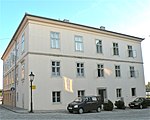
|
Former hotel, restaurant zur Post ObjectID : 17149 |
Heindlkai 1 location KG: Mauthausen |
In the place of the former Meierhof of Pragstein Castle, a three-storey building was erected in the 17th century, which in 1860 received a strictly historicized facade in the style of a Renaissance villa on the two upper floors, emphasizing the three-axis center. |
ObjectID : 17149 Status: § 2a Status of the BDA list: 2020-02-29 Name: Former Hotel, Restaurant zur Post GstNr .: .68 |

|
Bürgerhaus ObjektID : 17155 |
Heindlkai 9 KG location : Mauthausen |
The Seyerhaus, formerly the Weinbergerhaus, also served as the market's salt depot. The late Gothic corner house facing Bezirksgerichtsgasse with elements from the Gothic and Renaissance periods was adapted in the Baroque period. The notable elements include a late Gothic flat central bay window, a round corner bay window with a conical roof on a granite shell basket, Mary enthroned in a round-arched niche on the 2nd floor (copy, original from 1732 is in the interior of the house), Gothic window in front of the bay window with stonemason's mark on the underside of the windowsill. |
ObjectID : 17155 Status : Notification Status of the BDA list: 2020-02-29 Name: Bürgerhaus GstNr .: .55 Mauthausen Haindlkai 9 Seyerhaus |
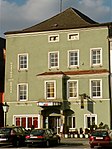
|
Gasthaus Grüner Kranz ObjectID: 17152 |
Heindlkai 11 KG location : Mauthausen |
Late-Gothic house with a facade from the end of the 16th century and renovations in the 1930s. The building consists of Renaissance style elements and a flat bay window. The remains of an arcade can still be found in the courtyard. |
ObjectID: 17152 Status: Notification Status of the BDA list: 2020-02-29 Name: Gasthaus Grüner Kranz GstNr .: .54 |
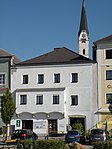
|
Bürgerhaus ObjektID : 37808 |
Heindlkai 13 KG location : Mauthausen |
Bürgerhaus am Heindlkai, which today houses the tourist information office. |
ObjectID : 37808 Status : Notification Status of the BDA list: 2020-02-29 Name: Bürgerhaus GstNr .: .53 |
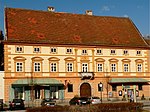
|
Former trading house ObjectID : 17157 |
Heindlkai 17 KG location : Mauthausen |
It was rebuilt around the middle of the 17th century in 1860 and was the seat of the Perger trading house with connections to St. Petersburg. Franz Perger was mayor of Mauthausen from 1909 to 1913 and from 1934 to 1935. On June 11, 1805, Emperor Franz I (II) stayed in the building . Since the renovation, the baroque facade has been designed in a mixed style between Biedermeier and historicism. |
ObjectID : 17157 Status : Notification Status of the BDA list: 2020-02-29 Name: Former trading house GstNr .: .51 |

|
Bürgerhaus ObjektID : 17158 |
Heindlkai 19 KG location : Mauthausen |
Late Gothic components with a baroque cantilever portal and the windows have a curved roof on two floors. Inside with barrel and groin vaults. |
ObjectID : 17158 Status : Notification Status of the BDA list: 2020-02-29 Name: Bürgerhaus GstNr .: .50 |

|
Stone walls and three portals ObjectID : 37818 |
Heindlkai 23 KG location : Mauthausen |
ObjectID : 37818 Status : Notification Status of the BDA list: 2020-02-29 Name: Stone walls and 3 portals GstNr .: .48 |
|

|
Lebzelterhaus ObjektID : 17159 |
Heindlkai 27 KG location : Mauthausen |
The narrow, deeply stretched building dates from the 16th century and has a late Gothic or Renaissance façade, which is decorated with baroque elements. The baroque facade decoration was added around 1760. The Michael Poschacher pastry shop was located in the building until 1983. The Lebzelterhaus was the parents' house of Anton Poschacher , the founder of the Poschacher Granitwerke, and is the ancestral home of the Poschacher family in Mauthausen. Noteworthy elements are the flat bay window above the side portal, the distinctive two-storey round arch bay window from the late Gothic and the statue of Maria Immaculata from the mid-18th century. To the right of the Lebzelterhaus is the narrowest street in the market, sometimes only 70 centimeters wide. |
ObjectID : 17159 Status : Notification Status of the BDA list: 2020-02-29 Name: Lebzelterhaus GstNr .: .45 |
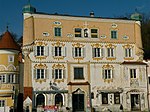
|
Bürgerhaus ObjektID : 17160 |
Heindlkai 29 KG location : Mauthausen |
The building, named after the dentist Königshofer as the Königshoferhaus, consists of two late Gothic houses that are combined by the facade. For decades the house was home to the Wedl family's inn and butcher shop. Königshofer designed the facade in 1989 in an idiosyncratic historicizing mixed style. The Renaissance blind facade extends high above the roof and has irregular window axes. The flat bay rests on stone consoles. The facade is bordered on both sides by round corner turrets. On the 3rd floor, in a barrel-shaped niche, there is a statue of St. Nicholas with a bishop's staff and anchor in his hands. |
ObjectID : 17160 Status : Notification Status of the BDA list: 2020-02-29 Name: Bürgerhaus GstNr .: .44 |

|
Residential building, former salt office building ObjectID : 17162 |
Heindlkai 33 KG location : Mauthausen |
The building is located at an important crossroads, as the Salzsteig, which leads over today's Kirchenweg towards Bohemia, crossed the Hauderer Straße built at the beginning of the 16th century at the Salt Office . It was not until 1832, with the opening of the horse-drawn railway from Linz to Budweis, that salt transport via Mauthausen lost its importance. The salt office and salt tower are in line of sight and form a traffic light system, as the Kirchenweg can only be used in one direction. |
ObjectID : 17162 Status : Notification Status of the BDA list: 2020-02-29 Name: Residential house, former Salt Office building GstNr .: .41 |

|
Schiffsmeisterhaus Object ID: 17163 since 2012 |
Heindlkai 34, 35 KG location : Mauthausen |
House built around 1500 with renovations in the 16th century and from 1960. A two-storey, three-winged building with a crooked roof. Window frames in the Renaissance style and the facade bears several high water marks (starting with 1682) as well as a spy window. Inside barrel and groin vaults. |
ObjektID : 17163 Status : Notification Status of the BDA list: 2020-02-29 Name: Schiffsmeisterhaus GstNr .: .39; .40 Mauthausen Heindlkai 34 35 Shipmaster's House |

|
Heinrichskirche ObjectID : 17147 |
Heinrichskirchenweg KG location : Mauthausen |
The Heinrichskirche stands on the eastern edge of the market, is also the chapel of St. Heinrich in der Au and is said to have been founded by Emperor Heinrich II, the saint (973 to 1024). From 1494 to 1507 there was a monastery established by Ladislaus Prager with three Carmelites. From 1550 to 1600 the church was a Protestant prayer house. A statue of the Virgin Mary washed up in the church led to a Marian pilgrimage with a large catchment area. The statue has been in the parish church of Mauthausen since 1892 . Of the original structure, only the east choir with a 5/8 end is preserved today. Two window tracery are still original. The church was restored at the end of the 19th century, whereby the allegedly dilapidated nave was torn down and the current west facade was redesigned. Mayor Leopold Heindl donated two neo-Gothic windows in 1898. Since the bank of the Danube was raised, the church has been below the street level of Donau-Straße. |
ObjektID : 17147 Status: § 2a Status of the BDA list: 2020-02-29 Name: Aufbahrungshalle , former branch church hl. Heinrich GstNr .: .25 Church Heinrichskirche in Mauthausen |

|
Grünbaum Chapel ObjectID : 17201 |
Kalvarienbergstrasse location KG: Mauthausen |
The Grünbaum Chapel is located two hundred meters north of the Kalvarienbergkirche after the 5th station of the Rosary Cross. It was built in 1725 and was a popular pilgrimage chapel in the 18th century. The neo-baroque gable building with an apse from around 1870 has a facade with pilaster strips and a wide arched portal. Inside there is a historical apse grille. The ceiling picture shows the green tree wonder. |
ObjectID : 17201 Status: § 2a Status of the BDA list: 2020-02-29 Name: Grünbaum-Kapelle GstNr .: .268 Grünbaumkapelle |

|
Kalvarienberg / Kreuzweg ObjectID : 17202 |
Kalvarienbergstrasse location KG: Mauthausen |
To the west of the parish church is the Rosary Way of the Cross, from which the first four stations date from 1775. After the 4th station one arrives at the Kalvarienbergkapelle, a baroque gable building with a simple plaster frame from the year 1728/34 with a baroque crucifixion group from the time around 1750 and background painting, whereby the three crucified are depicted as a sculpture and the three mourners on the painting. After the 5th station there is the Grünbaum Chapel. The Rosary Way of the Cross between Mair am Berg and Grünbaumkapelle consists of five stations with simple stone crosses with pictures on sheet metal. |
ObjectID : 17202 Status: § 2a Status of the BDA list: 2020-02-29 Name: Kalvarienberg / Kreuzweg GstNr .: .197 Mauthausen Kalvarienberg |

|
Caritaskindergarten ObjectID : 17168 |
Lindenweg 9 KG location : Mauthausen |
The building was inaugurated in 1916, was intended for a kindergarten group and a sewing school, but was initially used as a military hospital until the end of the First World War. In 1939 the National Socialist People's Welfare took over the building and the operation of the facilities housed there. In 1945 the Sisters of the Cross came back and ran the kindergarten on behalf of the parish. In 1957 the Diocesan Caritas acquired the building from the so-called German property. The building has since been thoroughly renovated and adapted to the increasing requirements. With the creation of additional rooms, three kindergarten groups are now accommodated there. |
ObjectID : 17168 Status: § 2a Status of the BDA list: 2020-02-29 Name: Caritaskindergarten GstNr .: .271 |

|
Fountain ObjectID : 17205 |
Marktplatz location KG: Mauthausen |
In the middle of the market square is the octagonal market fountain with the dates 1607 and 1716, which has a basin with drinking water on the south side. Both in 1898 on the occasion of the 50th anniversary of emperor Franz Joseph I set plane trees are protected since 1984th |
ObjectID : 17205 Status: § 2a Status of the BDA list: 2020-02-29 Name: Brunnen GstNr .: 738/38 Marktbrunnen Mauthausen |

|
Pillory ObjectID : 17206 |
Marktplatz location KG: Mauthausen |
The Mauthausen pillory originally stood opposite the Bräuhaus, was removed around 1800 after this type of penal system was discontinued, re-erected near the Heinrichskirche in 1905 and moved to the market square in 1936. The 2.2 meter high square shaft with the year 1583 is complemented by a pyramid with pine cones. On all four sides there are bas-reliefs depicting various offenses, which, however, cannot yet be assigned. |
ObjectID : 17206 Status: § 2a Status of the BDA list: 2020-02-29 Name: Pranger GstNr .: 738/38 |

|
Residential and commercial building, former brewery ObjectID : 17169 |
Marktplatz 4 KG location : Mauthausen |
The building was erected at the end of the 16th century. In 1870 the facade was renovated in the style of historicism. The municipal office was located there until 1896. In 1951 the house was extended and has had three floors since then. The renaissance gate with diamond cuboid framing and keystone with lion head from 1590 is remarkable. The early baroque sundial was renovated in 1696. |
ObjectID : 17169 Status: § 2a Status of the BDA list: 2020-02-29 Name: Residential and commercial building, former brewery GstNr .: .77 / 1 Mauthausen Bräuhaus |
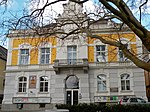
|
Town Hall / Municipal Office ObjectID : 17170 |
Marktplatz 7 KG location : Mauthausen |
New building around 1910 to 1915 with a late historical plaster facade and the market coat of arms as a facade image. |
ObjectID : 17170 Status: § 2a Status of the BDA list: 2020-02-29 Name: City Hall / Municipal Office GstNr .: .82 |

|
Bürgerhaus ObjektID : 17171 |
Marktplatz 11 KG location : Mauthausen |
Three-storey town house from the 16th century opposite the market fountain. In the side hall there are remarkable barrel vaults. |
ObjectID : 17171 Status : Notification Status of the BDA list: 2020-02-29 Name: Bürgerhaus GstNr .: .86 |

|
Bürgerhaus ObjektID : 17176 |
Marktstrasse 15 KG location : Mauthausen |
ObjectID : 17176 Status : Notification Status of the BDA list: 2020-02-29 Name: Bürgerhaus GstNr .: .106 |
|

|
Former salt tower ObjectID : 17177 |
at Marktstrasse 15, KG location : Mauthausen |
The salt tower on the Kirchenberg has a twelve-sided pyramid roof. A tablet made of Adnet marble was added in 1930. The salt tower served u. a. regulating traffic on the Salzstrasse. The flowering of the salt road leading via Mauthausen began at the end of the 17th century. In 1692, Emperor Leopold I introduced the salt monopoly and from this point on, salt was transported from Gmunden to Budweis via Mauthausen . |
ObjectID : 17177 Status : Notification Status of the BDA list: 2020-02-29 Name: Former salt tower GstNr .: 213 |

|
Parsonage Object ID: 17148 |
Pfarrplatz 1 KG location : Mauthausen |
The baroque rectory is located northwest of the parish church and was probably built around 1700 by the monastery builder Carlo Antonio Carlone . The ceilings are decorated with rich stucco by Giovanni Battista Carlone . |
ObjectID : 17148 Status: § 2a Status of the BDA list: 2020-02-29 Name: Pfarrhof GstNr .: .124 Mauthausen Pfarrhof |

|
Catholic parish church hl. Nikolaus ObjectID : 17145 |
Pfarrplatz 122 KG location : Mauthausen |
The late Gothic parish church of St. Nikolaus am Kirchberg, built at the end of the 15th century, is located on the site of the church that was destroyed by the Hussites in 1424. In 1522 the Anna chapel was added, in 1689 the Gothic spandrel tower was raised and given a baroque onion dome. In 1670 the church was redesigned in baroque style. In 1796/97 the church received four altarpieces by Martin Johann Schmidt (Kremser Schmidt). In 1901 the tower received the pointed helmet designed by the Linz cathedral builder Mattäus Schlager. The organ built in 1897 was replaced in 2000 by a parapet organ from the Rieger company with around 1200 pipes and 23 registers. The church is a hall church with three naves of equal height. The church is richly furnished with works of art, statues and pictures. Until 1901 there was a cemetery around the church. |
ObjectID : 17145 Status: § 2a Status of the BDA list: 2020-02-29 Name: Catholic parish church hl. Nikolaus GstNr .: .122 Parish Church in Mauthausen |

|
Former Salzstadl ObjectID : 17179 |
Poschacherstraße 2 KG location : Mauthausen |
The renovated building is now part of the Donaupark Mauthausen shopping center . Was built around 1807 as three elongated structures and served as a salt deposit until 1826. Later as shipbuilding. and stonemasonry. |
ObjectID : 17179 Status : Notification Status of the BDA list: 2020-02-29 Name: Former Salzstadl GstNr .: .1 |
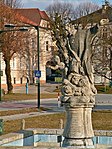
|
Figure St. Johannes Nepomuk ObjectID : 17204 |
Promenade location KG: Mauthausen |
The statue of the saint was made in 1730 by order of Franz Ernst von Härsewinkel, salt minister, and placed on the salt square as the protector of the salt boatmen. In 1941 it was demolished as a worthless concrete cast. The couple Ilsa and Anton Poschacher saved the figure from complete destruction, so that it could be put up again in 1954 on the square in front of the elementary school. |
ObjectID : 17204 Status: § 2a Status of the BDA list: 2020-02-29 Name: Figur hl. Johannes Nepomuk GstNr .: 738/42 |

|
Bürgerhaus, Gasthof Steinmayr ObjectID : 17182 |
Promenade 5 KG location : Mauthausen |
The building is not far from Pragstein Castle. |
ObjectID : 17182 Status : Notification Status of the BDA list: 2020-02-29 Name: Bürgerhaus, Gasthof Steinmayr GstNr .: .71 |
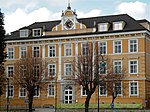
|
Elementary school ObjectID : 17186 |
Promenade 14 KG location : Mauthausen |
The elementary school was built in 1893 on the former Fröschlgarten and opened in 1898 after Anton Poschacher had given this property to the market community. The decorative gable and clock were removed in 1965. A clock was only reinstalled in 2000 when the attic was being converted. The facade in the Wilhelminian style shows four giant pilasters. The curved volutes on both sides of the clock were modeled on the ideas of the Renaissance architect Leon Battista Alberti . |
ObjectID : 17186 Status: § 2a Status of the BDA list: 2020-02-29 Name: Volksschule GstNr .: .244 |

|
Pragstein Castle ObjectID : 17144 |
Schloßgasse 1 KG location : Mauthausen |
The moated castle in the Danube, built by Ladislaus Prager at the end of the 15th / beginning of the 16th century, is located on the Danube between Schlossgasse and Donau-Straße. In 1867 or 1840 the arm of the Danube between Pragstein and the place was filled in. |
ObjectID : 17144 Status: § 2a Status of the BDA list: 2020-02-29 Name: Schloss Pragstein GstNr .: .69 Schloss Pragstein |

|
Villa Poschacher ObjectID : 22414 |
Vormarktstraße 9 KG location : Mauthausen |
It is the headquarters of the Poschacher family. The neo-baroque building in villa style was the result of a total renovation of the old Kamptnerhaus in 1903 under architect Max Kaiser. The villa has neo-baroque castle elements on the northwest side, such as a rounded intermediate building and a tower. The window grilles show Biedermeier forms. The statue of St. Barbara in front of a tower. |
ObjectID : 22414 Status : Notification Status of the BDA list: 2020-02-29 Name: Villa Poschacher GstNr .: .33 / 1 |

|
Fountain ObjectID : 17203 |
Mauthausen location KG: Mauthausen |
Rectangular fountain with the year 1765 |
ObjectID : 17203 Status: § 2a Status of the BDA list: 2020-02-29 Name: Brunnen GstNr .: .124 |

|
Karner St. Barbara ObjectID : 17146 |
Mauthausen location KG: Mauthausen |
The Karner is St. Dedicated to Barbara, is located on the church forecourt and is a Romanesque round building with an octagonal structure with a pyramid roof that was created in the Gothic period. The fresco from the 1480s on the south side shows St. Christophorus as well as the inscription AEIOU and is very faded. The frescoes inside (Christ as Judge of the World, flanked on the right and left by a bishop in the apse, triumphal arch with Mary and John the Baptist, 6 round medallions with doves and in the crown the Lamb of God with the risen flag as symbols for the seven gifts of the Holy Spirit or for the book with seven seals, angels with tools of the Passion above the window on the north wall, on the left St. Veronica and under the window the flagellation of Christ, south and west wall Michael with the dragon, St. Helena, mother of the Emperor Constantine , Catherine of Alexandria, south wall train of the apostles led by Paul) date from around 1260 and were only rediscovered in 1907. The jagged style used has Byzantine roots. The modern apse window from 1982 was created by Lydia Roppolt . |
ObjectID : 17146 Status: § 2a Status of the BDA list: 2020-02-29 Name: Karner hl. Barbara GstNr .: .123 |

|
Old cemetery and church stairs ObjectID : 17197 |
Mauthausen location KG: Mauthausen |
The church stairs lead from the eastern side of the market square to the parish church. The old cemetery is laid out to the east, south and southwest of the parish church. There is u. a. the Karner from the 13th century and the grave of the Poschacher family. |
ObjectID : 17197 Status: § 2a Status of the BDA list: 2020-02-29 Name: Alter Friedhof und Kirchenstiege GstNr .: 177/1; 738/18; 738/19 Old cemetery and church stairs , Mauthausen |
swell
- Peter Adam, Beate Auer, Susanne Bachner, Brigitta Fragner, Ulrike Knall-Brskovsky, Anna Piuk, Franz Peter Wanek, Monika Wiltschnigg: The art monuments of Austria. Dehio Handbook Upper Austria. Volume I, Mühlviertel. 1st edition. Verlag Berger & Söhne, Ferdinand, 2003, published by the Federal Monuments Office, ISBN 3-85028-362-3 .
- Eckhard Oberklammer : District of Perg - Art and History , Linz 2010, ISBN 978-3-85499-826-6 , pp. 106-124.
Web links
Commons : Listed objects in Mauthausen - collection of pictures, videos and audio files
Individual evidence
- ↑ a b Upper Austria - immovable and archaeological monuments under monument protection. (PDF), ( CSV ). Federal Monuments Office , as of February 18, 2020.
- ^ Homepage of Mauthausen an der Donau
- ↑ Eckhard Upper bracket: District Perg - Art and History. Linz 2010, ISBN 978-3-85499-826-6 , p. 115.
- ↑ Eckhard Upper bracket: District Perg - Art and History. Linz 2010, ISBN 978-3-85499-826-6 , p. 110.
- ↑ a b Eckhard Upper bracket: District Perg - Art and History. Linz 2010, ISBN 978-3-85499-826-6 , p. 111.
- ↑ Eckhard Upper bracket: District Perg - Art and History. Linz 2010, ISBN 978-3-85499-826-6 , pp. 111f.
- ↑ Eckhard Upper bracket: District Perg - Art and History. Linz 2010, ISBN 978-3-85499-826-6 , p. 112.
- ↑ Eckhard Upper bracket: District Perg - Art and History. Linz 2010, ISBN 978-3-85499-826-6 , pp. 114f.
- ↑ a b Eckhard Upper bracket: District Perg - Art and History. Linz 2010, ISBN 978-3-85499-826-6 , p. 124.
- ↑ Chronicle on the kindergarten homepage ( page no longer available , search in web archives ) Info: The link was automatically marked as defective. Please check the link according to the instructions and then remove this notice. queried on October 2, 2011
- ↑ a b Eckhard Upper bracket: District Perg - Art and History. Linz 2010, ISBN 978-3-85499-826-6 , p. 107.
- ↑ Eckhard Upper bracket: District Perg - Art and History. Linz 2010, ISBN 978-3-85499-826-6 , pp. 123f.
- ↑ Eckhard Upper bracket: District Perg - Art and History. Linz 2010, ISBN 978-3-85499-826-6 , pp. 116ff.
- ↑ a b Eckhard Upper bracket: District Perg - Art and History. Linz 2010, ISBN 978-3-85499-826-6 , p. 108.
- ↑ Eckhard Upper bracket: District Perg - Art and History. Linz 2010, ISBN 978-3-85499-826-6 , p. 112f.
- ↑ Eckhard Upper bracket: District Perg - Art and History. Linz 2010, ISBN 978-3-85499-826-6 , pp. 122f.
- ↑ § 2a Monument Protection Act in the legal information system of the Republic of Austria .